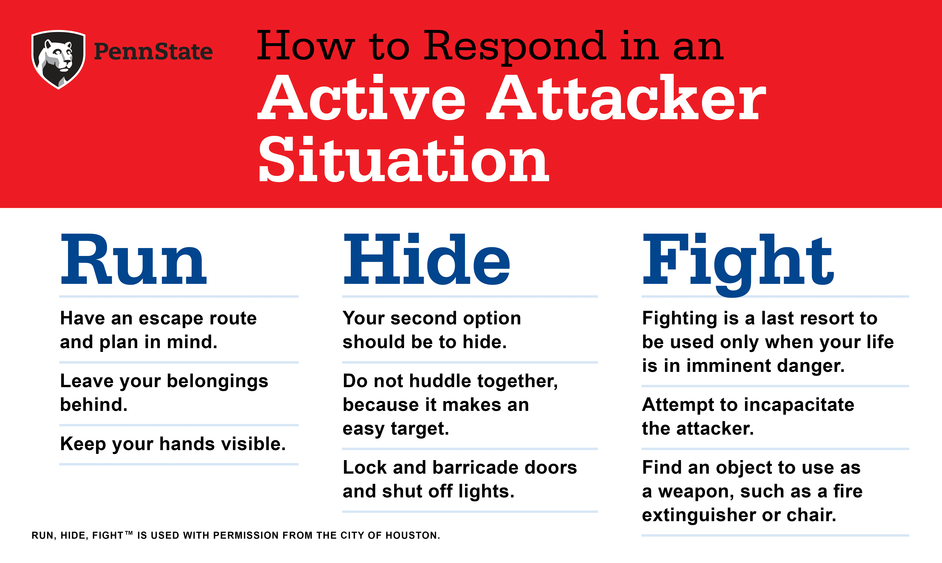
ABINGTON, Pa. — As part of National Preparedness Month, Penn State University Police and Public Safety reminds students, employees and visitors to familiarize themselves with the University’s official Active Attacker Response Program to learn more about how to react when encountering a potentially life-threatening situation anywhere.
Based upon the Run, Hide, Fight model developed by the City of Houston, Penn State’s Active Attacker Response offers the same three action steps if confronted with an active assailant, making it easy to remember and act upon in an emergency: run if you can, hide if you can’t, and fight as a last resort.
“While it can be difficult to think about the possibility of an active-attacker situation, it is important for everyone to have a plan in mind should they ever find themselves in a life-threatening situation,” said Charlie Noffsinger, assistant vice president for University Police and Public Safety.
Police and Public Safety at Penn State Abington plans to offer a series of safety trainings. The first, Active Shooter Readiness Training, will be held from noon to 1:30 p.m. on Sept. 25 in the Lares Banquet Room. The dates of future workshops will be announced on the listserv and in News From Sutherland.
The University regularly reminds the Penn State community about the Penn State Active Attacker Response and its action steps — run, hide and fight — because emergency preparedness is critical and requires everyone’s attention, according to David Gray, senior vice president for Finance and Business.
The run, hide, fight concept is endorsed at the local, state and federal levels, including by the U.S. Department of Homeland Security and the FBI.
University Police and Public Safety has robust policies and procedures in place for active-attacker situations, and Penn State police officers train regularly for such circumstances; however, it is vital that community members take the time to familiarize themselves with the University’s Active Attacker Response Program because it is designed to provide people with options that may help them survive an attack in the first crucial moments before police arrive on the scene.
Depending on individual circumstances, it is important to note that the run, hide and fight action steps may not always occur in this order, so memorizing them all as possible options, regardless of order, is essential.
Beyond the program’s namesake actions, University Police is providing the following additional guidance to community members on what to do during each step in the process.
Run
— Have an escape route and plan in mind.
— Make sure it is safe to leave the area. Use your eyes and ears to determine if it is safe to run.
— Leave your belongings behind.
— Keep your hands visible.
— Once in a safe place, call 911 and give detailed information about what is happening. Don’t assume someone else has already called the police.
Hide
— If unable to run from the danger, your second option should be to hide.
— Find a place that’s out of the attacker’s sight and remain quiet.
— Do not huddle together because it creates an easier target.
— Lock and barricade doors with whatever is available, such as desks, chairs, or door wedges. Shut off lights.
Fight
— Fighting is a last resort to be used only when your life is in imminent danger. (However, sometimes fighting may be the first and only option.)
— Find an object to use as a weapon, such as a fire extinguisher, backpack, book or chair.
— Attempt to incapacitate the attacker; commit to your actions; work with others to disable the assailant.
University Police and Public Safety routinely offers Active Attacker Response Program training to campus groups, and such training can be requested at https://police.psu.edu/community-education.
If you are unable to attend a training session, you may watch an online training video produced by WPSU and University Police illustrating the run, hide, fight steps in action.
As a warning, the video contains intense depictions of violence. It is designed in a realistic manner to educate the Penn State community on best practices for responding to a violent attack. However, it does not provide comprehensive guidelines for all scenarios and does not guarantee safety.
The video can be accessed at https://runhidefight.psu.edu. Viewer discretion is advised.
Employees who may find it difficult to review such subject matter can seek support through the Employee Assistance Program. Students at Abington can find support at https://abington.psu.edu/counseling-psychological-services/make-appointment.
In the event of any report of an active shooter or attacker, a rapid response by law enforcement to the scene and communication to the community by email, text, telephone and social media using the University’s PSUAlert system would occur. Initial alert messages would quickly be followed by critical information and regular updates.
All Penn State students, faculty and staff receive PSUAlert messages by email, and anyone can choose to receive messages by text message or phone call as well by visiting http://PSUAlert.psu.edu/. Users can choose to receive alerts for multiple Penn State campuses. In the event of an emergency, PSUAlert will be used to provide the campus community with critical information.
About Penn State Abington
Penn State Abington provides an affordable, accessible and high-impact education resulting in the success of a diverse student body. It is committed to student success through innovative approaches to 21st century public higher education within a world-class research university. With 3,500 students, Penn State Abington is a residential campus that offers baccalaureate degrees in 21 majors, undergraduate research, the Schreyer honors program, NCAA Division III athletics, and more.